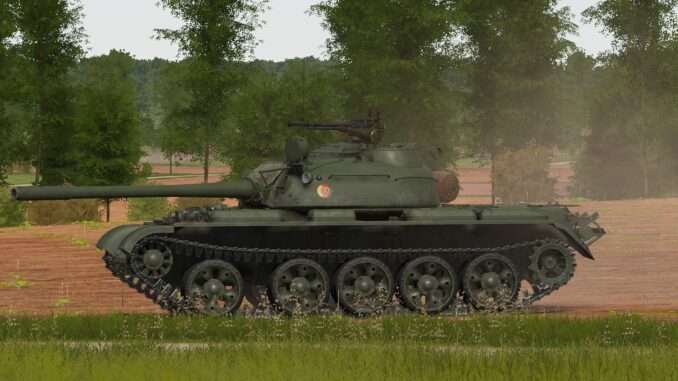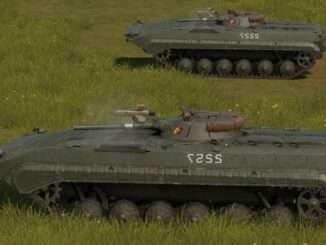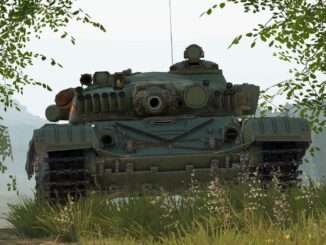
T-55A Guide
The T-55A is a medium tank produced by the Soviet Union and used by an astonishing variety of military units over the years. By all accounts, the T-54/T-55 is broadly the most numerous tank ever produced, with some production estimates reaching nearly 100,000 units. In the GHPC demo, the T-55A is featured in the service of the East German National People’s Army, or Nationale Volksarmee (NVA). While the USSR had moved on to newer and better tanks by the 1980s, the NVA still had in its ranks a great number of older tanks, including some fairly basic T-55A examples like this. The T-55A is, and will likely remain for some time, the oldest tank design featured in GHPC.
As usual, we have modeled the gunnery systems of the T-55A in great detail, and in order to use it effectively in battle, you will need to learn how it works. This guide will teach you all there is to know about T-55A gunnery in GHPC.
Overview
Unlike many of the other tanks in GHPC, the T-55A lacks a sophisticated fire control system, or any kind of fire control system at all. It has no laser rangefinder, no automatic lead compensation, and very limited night vision capabilities. If not for the stabilization system, it would be essentially a World War 2 era tank. Due to these significant disadvantages, players who find themselves operating a T-55A in GHPC will need to be well practiced on its systems, as well as relying heavily on tactics, rather than weaponry, to put themselves at an advantage.

Above: The T-55A was severely outdated by the 1980s, but thanks to advancements in ammunition, its 100 mm main gun could still deliver a punch.
Gunner’s sight
The T-55A has a simple, proven primary sight: the TSh2B-32P. The latest in a long line of revisions to the same Russian sight family, this sight features an array of sliding range scales corresponding to various types of ammunition. A horizontal line marks the current superelevation of the main gun on these scales. The gunner, keeping in mind which type of ammo is currently loaded, need only read the correct scale to adjust the range.
In GHPC, range can be manually adjusted with the PgUp and PgDown keys by default, or by holding left Ctrl and using the mouse scroll wheel.

Above: Each ballistic scale on the TSh2B-32P is labeled in Cyrillic characters based on the original Russian ammunition names. The English translations are provided on this image. In GHPC, for player convenience and to simulate a trained crew, the correct scale is used automatically. Here, the sight is set to 1400 meters with HEAT loaded.
Below: Now, the sight is still set for 1400 meters, but for APFSDS. The much flatter trajectory of subcaliber rounds leads to a highly compressed ballistic scale. (Fun fact: the “P” in the sight’s name means that this subcaliber scale has been added to the sight. Before APDS ammunition became common, the original TSh2B-32 did not have this scale.)

The TSh2B-32P has two levels of zoom: 3.5x and 7x. You can use the mouse scroll wheel to switch between these.
Rangefinding
Due to the lack of a laser rangefinder on the T-55A, the gunner must range the weapon the old fashioned way: using landmarks or the stadia rangefinder in the gunsight reticle. The stadia rangefinder is a labeled curved scale, calibrated so that an object of a certain size will fit it at every distance marked on the scale. In the case of the TSh2B-32P, the stadia rangefinder is calibrated for a height of 2.7 meters. This is a bit short for an M60 or M48 but about right for a Leopard 1. For ranging an M60A3, the turret roof (excluding the cupola) is a good reference point. Players can refer to the small “2,7” marking near the scale as a hint. The range marking on the left side of the scale is equivalent to 1220 meters, the point blank range of BR-412B and BR-412D ammunition.

Above: Using the stadia reticle to estimate the range to an M60A3 at 1300 meters distance. The measurement shown here lines up with the turret roof since, at nearly 3.3 meters, the tank is too tall for the reticle’s intended target height of 2.7 meters.
Given the time-consuming nature of ranging targets with the stadia reticle, as well as the massive potential for error in the measurement, it is recommended to use battlefield landmarks and tactical map knowledge to judge range when crewing a T-55A. Of course, this becomes much less of a concern when using subcaliber ammunition types such as APFSDS, as their ballistic drop is much more forgiving.
Movement and lead
The T-55A has no built-in mechanism for lead compensation, nor does it account for the tank’s own momentum imparted to shots on the move. It is most accurate from a stationary position against a stationary target. If it becomes necessary to engage moving targets, the gunner must use some judgment and line up the target with the tick marks to the left or right of the main aiming mark.
Night sight and infrared illuminator
Much like other Soviet armored vehicles of the era, the T-55A is equipped with a night vision sight of the image intensification type. This sight functions by amplifying light with the use of a phosphor film, which gives it the characteristic green tint. The T-55A has a TPN-1-22-11 night sight, a first-generation night vision device with decidedly poor performance compared to later models. In order to be effective, it requires the assistance of an infrared (IR) illumination spotlight (in this case, the Luna 2 spotlight mounted near the base of the gun). Even with the IR light switched on, the night vision system is only effective inside of 1 km. The sight has a fixed magnification of 5.5x and does not visibly adjust for range or ammunition selection.
In GHPC, the night sight is accessed via the T key by default, and the IR spotlight can be switched on via the quick menu (default: Q) or a direct shortcut (default: N).

Above: comparison of an object at about 500 meters distance, without the IR illuminator (left) and with it (right)
Below: targets observed from about 800 meters with assistance from Luna 2

The night sight on the T-55A is not resistant to bright light and could be permanently damaged by overload. To guard against this, it is covered by a solid cover during the day. In GHPC, the covers for the Luna 2 and the TPN-1-22-11 are automatically applied and removed based on the time of day.

Above: T-55A turret with and without covers on the IR spotlight and night sight
The illumination assisted (“active”) IR night vision has some notable flaws that a prudent player should keep in mind. For one, any vehicle using an IR intensifier night sight will be able to see your spotlight and its beam. This can give away your position quite easily, and if the enemy vehicle does not have its own illuminator, the battle will be very one-sided.

Above: Using the night sight to observe another vehicle whose IR illuminator is switched on. Note the stark offset shadows from the viewing vehicle’s own spotlight.
Below: Using the beam from another vehicle’s IR illuminator to observe the area ahead without revealing one’s own position

Another annoyance from the use of active IR night vision is the intensity with which dust and smoke are picked up in the view and block effective vision. The spotlight will glare off of any suspended particles, rendering the system essentially useless until things settle.

Above: Attempting to observe an ongoing battle through the cloud of dust kicked up by the viewing vehicle’s own main gun
There is one more option for low light combat aside from the night sight: the day sight’s reticle can be illuminated in the orange color typical of Russian optics. This is likely not the best option for true night conditions, but it can help in low light or if the background is too dark to properly read the reticle. In GHPC, reticle illumination is controlled via the I (i) key by default.

Ammunition
The T-55A is equipped with the 100 mm D-10T2S tank gun, a weapon with a long lineage leading back to the original D-10 gun in the second world war. There is a large variety of ammunition that is compatible with this gun, including everything from basic AP and HE rounds to guided missiles.
In the GHPC demo, the T-55A is equipped with an uncommonly large variety of ammunition types: HEAT-FS, APFSDS, HE-Frag, and old-fashioned APHE. These rounds are all useful for different scenarios, and a skilled player will use the right ammunition for whatever task presents itself. As a rule of thumb, APFSDS is for tanks and long range accuracy, HE is for light vehicles and infantry, and HEAT-FS is a balanced round for medium duty with excellent damage retention at long distance.

Above: A selection of 100 mm ammunition in GHPC. From top to bottom: 3OF412, BR-412D, 3BM25, 3BK5M
Conclusion
Despite being handily outclassed by the latest comers in the 1980s, the T-55A is still a tank, and it’s more than capable of fulfilling its role as such. If handled with an abundance of caution and the sense to strike at the right moments, this battle-tested chariot can bring the pain against all kinds of targets.





Be the first to comment